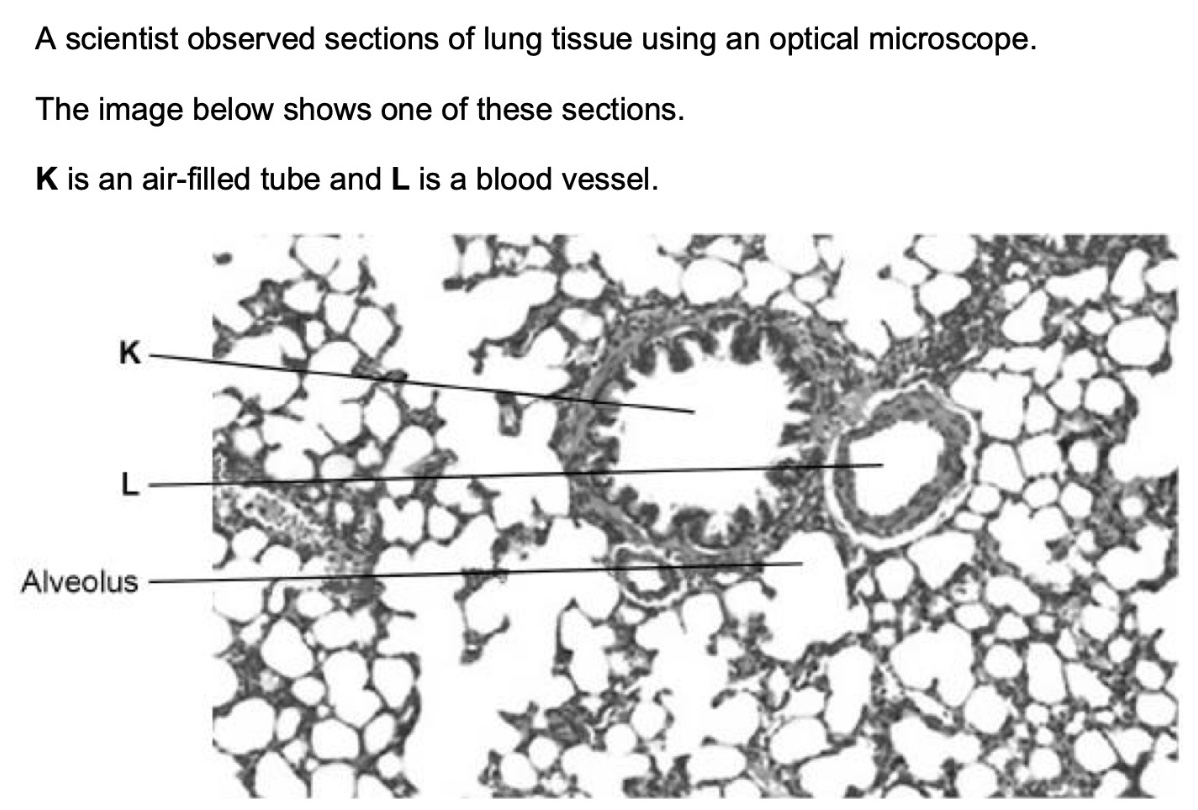gas exchange - humans
1/20
There's no tags or description
Looks like no tags are added yet.
Name | Mastery | Learn | Test | Matching | Spaced |
|---|
No study sessions yet.
21 Terms
If alveolar epithelium cells die inside the human body they are replaced by non-specialised, thickened tissue.
Explain why death of alveolar epithelium cells reduces gas exchange in human lungs.
1. reduces surface area
2. increased distance for diffusion
3. reduced rate of gas exchange

identify the structures labelled K and L
K = bronchiole
L = arteriole
Two solutions often used to stain tissues are haematoxylin solution and iodine solution.
• Haematoxylin solution stains DNA a blue colour.
• Iodine solution stains starch a blue-black colour.
The scientist used haematoxylin solution and not iodine solution to stain the lung tissue.
Suggest why.
1. lung tissue does not contain starch
2. makes nucleus visible
gas exchange in humans
- aerobic organisms require oxygen to release energy in the form of ATP during respiration
- CO2 needs to be removed
- volumes of these gases are large as:
→ mammals are large organisms with a large number of living cells
→ they maintain a high body temp and have high metabolic and respiratory rates
gas exchange pathway in humans
nose/mouth → trachea → bronchus → bronchiole → alveoli → RBC in blood
lungs
- in all mammals, gas exchange takes place in the lungs
- adapted to have very large SA in close contact with bloodstream, so oxygen can diffuse into blood, and carbon dioxide diffuse out
c shaped cartilage
- trachea connects lungs to mouth and is the piece that connects the two lungs together
- trachea has horizontal “c”-shaped rings around the trachea that act as reinforcements so the trachea doesn’t collapse in on itself when air is breathed in
specialised cells in trachea and bronchi
- on their internal walls that help protect the lungs
- ciliated epithelial cells and mucus secreting goblet cells
- work in conjunction to trap dirt and pathogens (in mucus) and pass these to stomach (using cilia)
alveoli
- surrounded by collagen and elastic fibres
- the elastic fibres allow alveoli to stretch during inhalation and return back to their original position during exhalation
- gas exchange occurs on the alveolar membrane
alveolar features of efficient gas exchange
- the alveolar epithelium is one cell thick, creating a short diffusion pathway
- circulation of blood, so a conc gradient is maintained for diffusion
- alveoli walls are folded, so provides a large SA so faster rate of diffusion
- narrow lumen of the capillaries → RBCs are wrapped around and pressing against the inside of the capillary
- permeable; allows diffusion of oxygen
how is high concentration gradient maintained in alveoli?
- heart pumps blood through capillaries and over alveoli
- the ventilation system keeps the gases present in the lungs
narrow lumen of the capillaries
- RBCs are squeezed through
- reduces the speed they travel at
- allows for more diffusion to take place
ventilation
- the movement of air in to and out of the lungs
- uses muscles involuntarily
- inhalation and exhalation of air - caused by muscle contractions and change in air pressure - internal intercostal muscles and external intercostal muscles are antagonistic
which 3 sets of muscles carry out the changing of pressure in the lungs?
1. diaphragm
2. internal intercostal muscles
3. external intercostal muscles
inspiration (inhalation)
- active process
- external intercostal muscles contract and internal intercostal muscles relax, this causes the ribs to be pulled up and out
- diaphragm contracts, flattening out, pulling diaphragm down
- increases volume of the thorax
- decreases pressure inside lungs
- as the atmospheric pressure is greater, the air is pulled in to the lungs
expiration (exhalation)
- mostly passive process
- internal intercostal muscles contract and external intercostal muscles relax, causing ribs to be moved down and in
- diaphragm relaxes and pushes upwards as the contents of the abdomen push back against it
- decreases volume of thorax and increases pressure in lungs
- as the atmospheric pressure is now lower, the air is forced out of the lungs and in to the atmosphere
equation of pulmonary ventilation rate (dm3min-1)
tidal volume (dm3) x breathing rate (min-1)
lung disease risk factors
smoking, air pollution, genetics, infections
why do mammals require larger volumes of gases?
mammals have larger number of cells so require larger volumes of gases to maintain body temperature (so high metabolic rates)
measures of lung function
1. forced expiratory volume (FEV)
2. forced vital capacity (FVC)
describe the pathway taken by an oxygen molecule from an alveolus to the blood.
1. across alveolar epithelium
2. epithelium of capillary